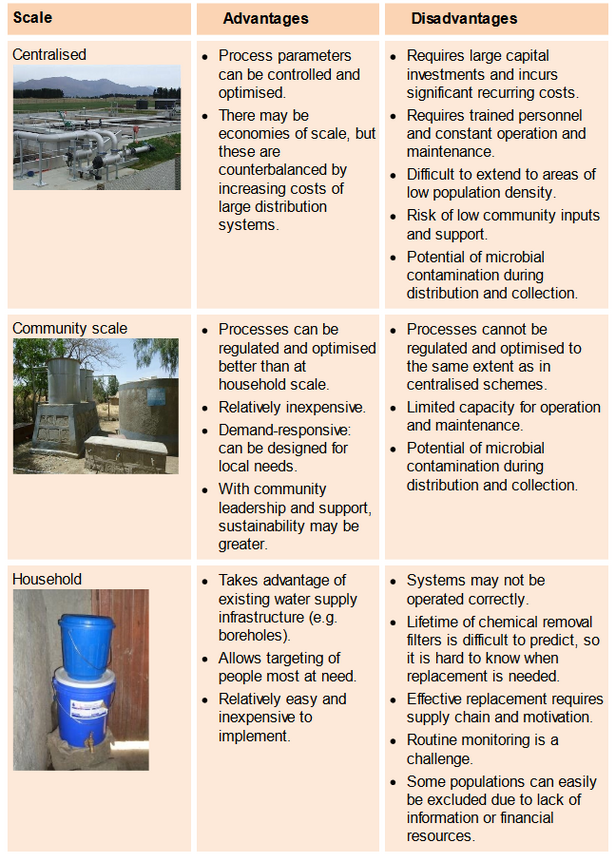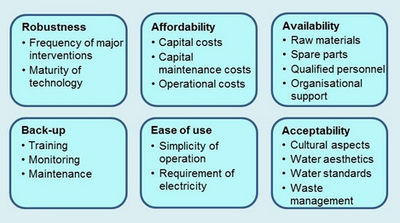Can contaminated groundwater be cleaned up?
Mitigation Options for Groundwater Contamination
It can be very difficult to determine the best technological approach for providing water free of arsenic and fluoride. Often people think first of contaminant removal technologies, but it may be more cost-effective and sustainable to exploit alternative water resources. In either case, some sort of water treatment is likely to be necessary to ensure both chemical and microbial water safety. A wide range of technological options are available at different scales: in professionally managed centralised plants, in small community-scale systems or at the household level. Each of these scales has advantages and disadvantages, and the most suitable solution is determined by the local context (Table 7.1).
Introducing a new technology is a complex process, which should be participatory, involving all stakeholders from the outset. The institutional framework, legislation, funding, support and long-term financing needs to be determined, as is promoting safe water use among the affected population and facilitating behaviour change. Insufficient operation and maintenance (O&M) can quickly lead to technological failure, so these aspects need to also be planned and considered before the technology is installed. The Operation and Maintenance Network gives useful tools and information on this issue. Detailed information on the whole process of supporting sectors in scaling up WASH technology is presented in the Technology Applicability Framework (TAF) of the WASHTech project.

Table 7.1 Drinking-water treatment at different scales (Terms of use: Cite original source from Handbook)
Water Safety Plans:
Water Safety Plans (WSP) can provide a systematic means to address and manage health-related water risks. They provide a practical framework to implement a systematic, risk-based approach to most effectively ensure consistent supplies of safe drinking water. The WSP approach requires that hazards and associated risks be identified in the entire water supply chain, from catchment to point of use, and it gives a framework for the prioritisation and management of those hazards and risks (Bartram et al., 2009; WHO, 2012; WHO/IWA, 2013). WHO and its partner organisations, including the International Water Association (IWA), actively support the WSP approach. Several tools exist to assist in the development and implementation of WSPs (WHO 2012; WHO/IWA 2013).
WHO (2012) Water safety planning for small community water supplies: step-by-step risk management guidance for drinking-water supplies in small communities. World Health Organization, Geneva, Switzerland.
WHO/IWA (2013) Water safety plan quality assurance tool. World Health Organization, Geneva, Switzerland.
Difficult questions to answer:
Which water resource should be developed? Is it better to remove the chemical or to find a chemically safe resource?
- Which technology is best suited for water treatment in this particular setting?
- On which scale can this technology best be applied?
Answers should be based on the combined understanding of available water resources, institutional setting, financing strategies and acceptability. Those responsible for water supply often have to make choices between these different approaches without a solid evidence base and sometimes without a clear method for taking decisions. A list of factors for the comparative evaluation of technologies is given below (Fig. 7.2).

Fig. 7.2 Selected criteria for technology evaluation (Terms of use: Cite original source from Handbook).
Note: The choice of technology heavily depends on local conditions. A filtration technology may be suitable for water with low contamination, whereas the same technology may be too expensive for highly contaminated water. In another region, salinity or industrial contamination may require the use of alternative water resources etc.
Water treatment: A fundamental difference between arsenic and fluoride
In geogenically contaminated water, arsenic concentrations can range from >10 to around 500 ng/L, while fluoride concentrations can be orders of magnitude higher, generally ranging from >1.5 to 20 mg/L. Filtration is a frequently used water-treatment technology. Since fluoride concentrations are so much higher than arsenic concentrations, more frequent regeneration and replacement of filter material is necessary, and the water treatment costs are subsequently higher.
NOTE: Article from the Geogenic Contamination Handbook
Keywords
Mitigation, groundwater contamination, water treatment, water safety, mitigation options, water resources, WHO, alternative water, drinking water, water supply, water safety plans, World Health Organization, geogenic contamination, WASH, fluoride, removal technologies, sustainable exploitation, salinity, industrial contamination, filtration, water treatment, arsenic, filter, material, safety, risk, technology, stakeholders, drinking-water supplies, technological options, water-treatment technology
For references, please visit the page
References - Geogenic Contamination Handbook.
Please find the PDF of the complete handbook chapter
Find more information about mitigations options
How communities can handle groundwater contamination?
Find more information in GAP Wiki
Mitigation options - Exploiting alternative water resources